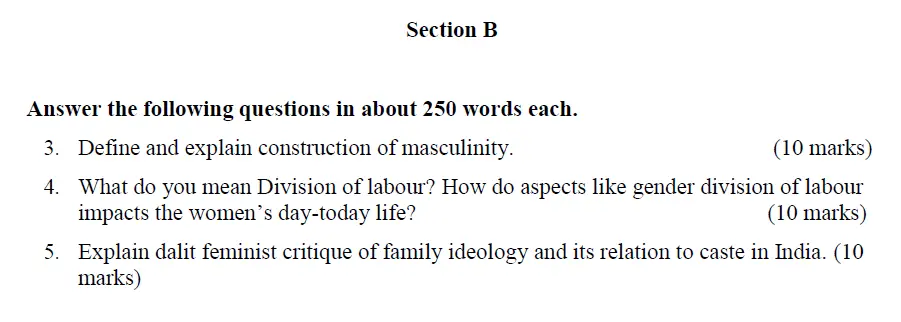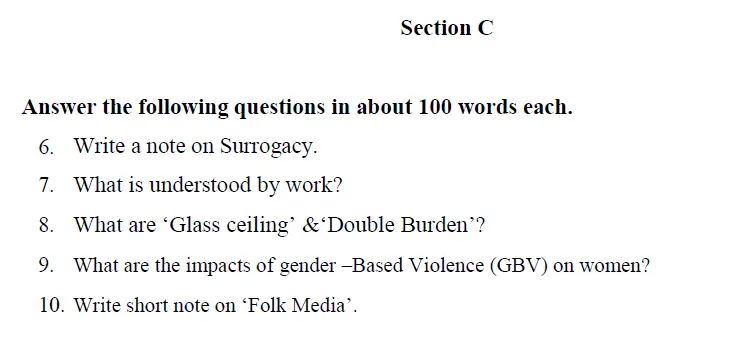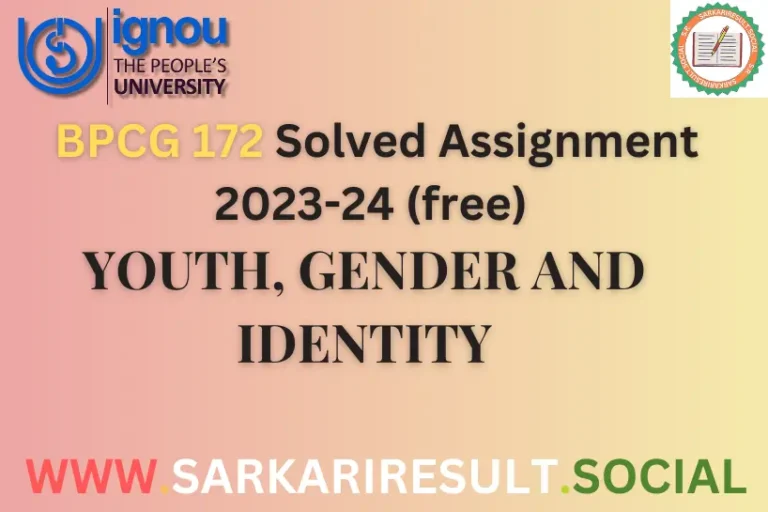Check BGDG 172 IGNOU solved assignment 2023-24 (Free)

BGDG 172 IGNOU solved assignment 2023-24 (Free)
“Explore the significance of gender sensitization in society and culture in the course of BGDG 172 and get the assignment of BGDG 172 IGNOU solved assignment 2023-24 (Free). Understand how economic systems influence various social aspects and vice versa. To help you succeed, we are offering a FREE solved assignment covering all categories (DCQs, MCQs, SCQs). Enhance your understanding, improve writing skills, and excel in the term-end examination. Don’t miss this opportunity to unlock academic excellence with our complimentary solved assignment.”
BGDG 172 Part A solved (Questions and Answers)

Q.1 Define sexuality. Do think sexuality is socially constructed? Support your arguments by providing suitable examples.
Ans. Sexuality refers to a person’s emotional, romantic, and sexual attractions, as well as their sense of identity in relation to these attractions.It encompasses a wide range of feelings, behaviors, and identities that people experience. While the basic concept of attraction is a part of human nature, how societies understand and interpret sexuality can vary widely. Some aspects of sexuality are influenced by biology, while others are shaped by cultural and social factors.
Sexuality can be understood through the lens of being socially constructed, which means that society’s beliefs and norms play a significant role in shaping how people perceive and express their sexuality. These beliefs and norms can influence what is considered acceptable or taboo, affecting how individuals understand and navigate their own feelings and desires.
One example of social construction is the concept of heterosexuality and homosexuality. In many cultures, heterosexuality (attraction to the opposite sex) has historically been the norm, while homosexuality (attraction to the same sex) was often stigmatized or even criminalized. This demonstrates how societal views can impact how people view and label their own attractions.
Another example is gender roles and expectations. Many societies have assigned specific roles and behaviors to individuals based on their gender. These expectations can influence how people express their sexuality, as individuals may feel pressure to conform to certain norms or hide their true feelings to avoid social scrutiny. For instance, a person might feel discouraged from expressing attraction to the same sex due to societal expectations of how their gender should behave.
Media and pop culture also play a role in shaping perceptions of sexuality. Movies, TV shows, and advertisements often depict certain types of relationships as desirable or “normal.” This can lead to the idea that there’s a single “right” way to experience attraction and relationships, potentially causing confusion or discomfort for individuals whose experiences don’t align with these portrayals.
However, it’s important to note that while societal influences are significant, they don’t entirely determine a person’s sexuality. People’s feelings and attractions are complex and personal. Some argue that a degree of biology is involved, as evidenced by studies suggesting genetic and hormonal factors may contribute to sexual orientation. This suggests that while societal factors can impact how people understand and express their sexuality, they don’t hold complete sway over one’s attractions.
In conclusion, sexuality is a multi-faceted aspect of human identity that encompasses emotional, romantic, and sexual attractions. It can be seen as socially constructed in the sense that societal beliefs, norms, and expectations influence how people perceive and express their attractions. Examples such as heterosexuality versus homosexuality and gender roles illustrate how societal factors can shape individual experiences of sexuality. However, while society plays a role, personal feelings and biological factors are also integral to understanding one’s sexuality.
Q.2 Men and Women are portrayed in advertisements according to the constructed definition of femininity and masculinity. Support your argument by providing suitable examples.
Ans. In advertisements, men and women are often portrayed according to specific ideas about femininity and masculinity that are constructed by society. These portrayals can reinforce traditional gender roles and expectations, shaping how people perceive themselves and others. Let’s explore this concept further with some examples.
**1. Masculinity Portrayals:**
Advertisements frequently depict men as strong, dominant, and in control. They may showcase men engaging in physically demanding activities, such as sports or manual labor, to emphasize their toughness. For instance, a car commercial might show a man confidently driving a rugged vehicle through challenging terrain, suggesting that being tough and adventurous is a “masculine” trait.
**2. Femininity Portrayals:**
On the other hand, women are often portrayed as nurturing, beautiful, and focused on appearance. Advertisements might feature women in elegant dresses, using beauty products, or taking care of children, reinforcing the idea that a woman’s primary role is to look attractive and care for others. For example, a cosmetic ad might show a woman using makeup to enhance her appearance, implying that looking beautiful is essential for a woman.
**3. Gendered Colors and Toys:**
Even products aimed at children contribute to these portrayals. Advertisements for toys often use specific colors and themes to target boys and girls differently. Boys’ toys might be advertised with bold colors like blue and feature action figures or vehicles, while girls’ toys might use pastel colors like pink and focus on dolls and domestic playsets. This reinforces the idea that boys should be interested in adventure and action, while girls should be interested in nurturing and domestic roles.
**4. Role Allocation:**
Advertisements sometimes depict men and women in traditional roles, such as men as breadwinners and women as homemakers. This sends the message that men should be responsible for providing for the family, while women should focus on domestic tasks. An advertisement showing a man coming home from work and being served dinner by his wife can perpetuate these stereotypes.
**5. Breaking Stereotypes:**
However, there are instances where advertisements challenge these stereotypes. Some ads show women in leadership roles, pursuing careers, and engaging in activities traditionally associated with men. These portrayals challenge the notion that women are limited to certain roles. For example, an advertisement featuring a female scientist can break down the idea that science is a “male” field.
In conclusion, advertisements often present men and women based on constructed definitions of femininity and masculinity. These portrayals reinforce traditional gender roles and expectations, showing men as strong and in control, and women as nurturing and appearance-focused. These messages can influence how people view themselves and others, and they can contribute to unequal gender norms in society. However, it’s important to recognize that some advertisements are starting to challenge these stereotypes by portraying men and women in non-traditional roles, promoting a more inclusive and equal representation of gender identities.
BGDG 172 Part B solved (Questions and Answers)

Q.3 Define and explain construction of masculinity.
Ans. Construction of masculinity refers to the way society creates and defines the behaviors, traits, and roles that are considered “masculine” or typical for boys and men. These ideas about masculinity are not set in stone, but rather they are shaped by the culture, history, and beliefs of a society.
In many societies, masculinity has been associated with traits like strength, toughness, and control. Boys and men might feel pressure to act in certain ways that align with these traits, such as avoiding showing emotions or always appearing confident. These expectations can affect how boys and men view themselves and how they interact with others.
Media, like movies, TV shows, and advertisements, play a big role in shaping these ideas of masculinity. They often show men as heroes who solve problems on their own, are physically strong, and don’t show vulnerability. These portrayals can influence boys and young men to think that they need to be tough and independent to be considered “real” men.
However, it’s important to know that there is no one “right” way to be masculine. Everyone is unique, and there are many ways to express masculinity. Some boys might enjoy playing sports, while others might prefer reading or art. Some men might be good at fixing things, while others might be great at listening and supporting their friends emotionally.
In recent times, there’s been a growing understanding that masculinity can be diverse and flexible. It’s okay for boys and men to have a range of interests, feelings, and ways of expressing themselves. The construction of masculinity is evolving, and it’s important to question and challenge the narrow definitions that society might impose, allowing everyone to feel comfortable being themselves.
Q.4 What do you mean Division of labour? How do aspects like gender division of labour impacts the women’s day-today life?
Ans. Division of labor refers to how tasks and responsibilities are distributed among different individuals or groups within a society or community. It involves assigning specific roles or jobs to people based on factors like their skills, abilities, and sometimes their gender.
Gender division of labor is when certain tasks or jobs are assigned to individuals based on their gender, with different expectations for men and women. In many societies, women have often been assigned tasks related to caregiving, such as taking care of children, cooking, and cleaning. Men, on the other hand, might be assigned tasks that are considered more physically demanding or prestigious, like working outside the home or making important decisions.
The impact of gender division of labor on women’s day-to-day lives can be significant. When women are expected to primarily take care of household chores and caregiving, it can limit their opportunities to pursue education, careers, or other interests. They may have less time and energy for personal growth and self-care.
Additionally, this division of labor can reinforce traditional gender roles and stereotypes. It can suggest that women are naturally suited for domestic tasks, while men are naturally better suited for leadership and economic activities. This can affect how women see themselves and how others perceive them, potentially leading to unequal treatment and opportunities.
Furthermore, when women’s work is not equally valued or recognized, it can contribute to economic disparities. Jobs that are often associated with women, such as caregiving or certain types of service work, may be paid less than jobs that are considered traditionally masculine. This can lead to financial challenges for women and their families.
In recent times, there has been a push for more equal division of labor and opportunities between genders. Many people and organizations are advocating for breaking down these gender-based barriers, allowing women to have more choices and opportunities in their lives. This way, women can pursue a wider range of careers, interests, and goals, leading to a more balanced and fair society.
Q.5 Explain dalit feminist critique of family ideology and its relation to caste in India.
Ans. Dalit feminist critique refers to the analysis and questioning of the traditional family ideology from the perspective of Dalit women in India. Dalits are historically marginalized communities often subjected to discrimination based on their caste. Dalit feminists examine how the family structure and its norms can reinforce and perpetuate caste-based inequalities.
In India, the family is often seen as a place of support and unity. However, Dalit feminists argue that the family can also be a site of oppression, especially for Dalit women. They point out that caste hierarchies can be deeply ingrained within families, leading to unequal treatment and exploitation. Dalit women might face discrimination and abuse from both upper-caste family members and society at large.
Furthermore, traditional family roles can limit the opportunities available to Dalit women. The division of labor based on caste can restrict their education and employment prospects, trapping them in low-paying and menial jobs. This cycle of limited opportunities can contribute to the perpetuation of caste-based inequalities.
The Dalit feminist critique challenges the idea that the family is always a safe and nurturing space. It highlights the need to address caste-based discrimination within families and society, advocating for equal rights and opportunities for Dalit women. By questioning the traditional family ideology and its relation to caste, Dalit feminists strive for a more inclusive and just society where all individuals, regardless of caste or gender, can live with dignity and respect.
BGDG 172 Part C solved (Questions and Answers)

Q.6 Write a note on Surrogacy.
Ans. Surrogacy is when a woman carries a baby for another person or couple who cannot have a baby on their own. The woman who carries the baby is called a surrogate. Surrogacy can be helpful for people who cannot have babies due to medical reasons. There are two types: traditional surrogacy, where the surrogate’s egg is used, and gestational surrogacy, where the embryo is created with the intended parents’ egg and sperm. Surrogacy involves legal agreements and medical procedures. It helps create families, but it also raises important ethical and legal questions.
Q.7 What is understood by work?
Ans. Work refers to activities people do to achieve a goal or produce something useful. It can be both physical, like building or cleaning, and mental, like solving problems or designing. Work is important for making things, providing services, and earning a living. It comes in various forms, from jobs to chores. Work requires effort and can contribute to personal growth, learning, and the well-being of individuals and society as a whole.
Q.8 What are ‘Glass ceiling’ &‘Double Burden’?
Ans. The ‘glass ceiling’ is an invisible barrier that can prevent certain groups, like women or minorities, from rising to top positions in jobs or careers, even if they have the skills and qualifications. It’s like an unfair limit on their progress.
‘Double burden’ is when someone, often women, has to manage both their job outside the home and their responsibilities at home, like taking care of family and household tasks. It’s like having two heavy tasks to handle at the same time, which can be challenging and tiring.
Q.9 What are the impacts of gender –Based Violence (GBV) on women?
Ans. Gender-Based Violence (GBV) has harmful effects on women. It can lead to physical injuries, emotional distress, and even death. GBV can lower self-esteem, making women feel scared and powerless. It restricts their freedom and opportunities, affecting education and work. It can cause long-term mental and physical health problems. GBV also reinforces harmful gender stereotypes, making it harder for women to achieve their potential. It’s important to stop GBV to create a safer and fairer world for everyone.
Q.10 Write short note on ‘Folk Media’.
Ans. Folk media is a creative way people share traditions and stories using art, music, dance, and storytelling. It’s like passing down culture from one generation to another. Folk media connects communities, preserves heritage, and celebrates local customs. It’s often simple, like songs or plays, and is easy for everyone to understand. Folk media helps keep traditions alive and teaches important lessons, making it a special way to learn about different cultures and histories.







